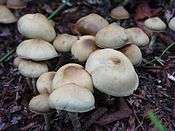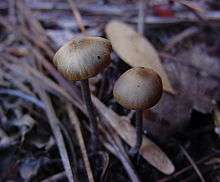List of Psilocybe species
This is a list of species in the agaric genus Psilocybe. A B C D E F G H I J K L M N O P Q R S T U V U W X Y Z
A
- Psilocybe acadiensis (Smith)
- Psilocybe acutipilea (Speg.) Guzmán, psychoactive
- Psilocybe aerugineomaculans (Hohn.) Singer & A.H. Smith
- Psilocybe allenii Borov., Rockefeller & P.G.Werner
- Psilocybe alutacea Y.S. Chang & A.K. Mills
- Psilocybe angustipleurocystidiata Guzmán, psychoactive
- Psilocybe antioquiensis Guzmán, Saldarr., Pineda, G. Garcia & L.-F. Velazquez, psychoactive
- Psilocybe atlantis Guzmán, Hanlin & C. White, psychoactive
- Psilocybe aquamarina (Pegler) Guzmán
- Psilocybe araucariicola P. S. Silva, likely psychoactive[1]
- Psilocybe armandii Guzmán & S.H. Pollock, psychoactive
- Psilocybe aucklandiae Guzmán, C.C. King & Bandala, psychoactive
- Psilocybe aztecorum R. Heim
- Psilocybe aztecorum var. bonetii (Guzman) Guzmán (a.k.a. Psilocybe bonetii Guzmán)
- Psilocybe azurescens Stamets & Gartz
B
- Psilocybe baeocystis Singer & A.H. Smith
- Psilocybe banderillensis Guzmán
- Psilocybe bispora Guzman, Franco-Molano and Ramírez-Guillén
- Psilocybe brasiliensis Guzmán
- Psilocybe brunneocystidiata Guzmán & Horak
C
- Psilocybe cabiensis Guzmán, M.Torres & Ram.-Guill[2][3]
- Psilocybe caeruleoannulata Singer ex Guzmán
- Psilocybe caerulescens
- Psilocybe caerulescens Murrill var. caerulescens
- Psilocybe caerulescens var. ombrophila (R. Heim) Guzmán
- Psilocybe caerulipes (Peck) Sacc.
- Psilocybe carbonaria Singer
- Psilocybe caribaea Guzmán, T.J. Baroni & Tapia
- Psilocybe chiapanensis Guzmán
- Psilocybe chuxiongensis T.Ma & K.D.Hyde
- Psilocybe cinnamomea J.F.Liang, Yang K.Li & Ye Yuan – China[4]
- Psilocybe collybioides Singer & A.H. Smith
- Psilocybe columbiana Guzmán
- Psilocybe congolensis Guzmán
- Psilocybe coprinifacies (Rolland) Pouzar s. auct., non s.Herink, non s. Krieglsteiner (see discussion)
- Psilocybe cordispora R. Heim
- Psilocybe cubensis (Earle) Singer
- Psilocybe cyanescens Wakef. (non sensu Krieglsteiner)
- Psilocybe cyanofibrillosa Guzmán & Stamets
D
- Psilocybe dumontii Singer ex Guzmán
E
- Psilocybe egonii Guzmán & T.J. Baroni
- Psilocybe eximia E. Horak & Desjardin[3]
F
- Psilocybe fagicola R. Heim & Cailleux
- Psilocybe farinacea Rick ex Guzmán (a.k.a. Psilocybe albofimbriata (Rick) Singer)
- Psilocybe fasciata Hongo
- Psilocybe ferrugineolateritia Smith
- Psilocybe fimetaria (P.D. Orton) Watling (a.k.a. Psilocybe caesieannulata Singer; Stropharia fimetaria P.D. Orton)
- Psilocybe fuliginosa (Murrill) A.H. Smith
- Psilocybe furtadoana Guzmán
- Psilocybe fuscofulva Peck, not psychoactive[5]
G
- Psilocybe galindoi Guzmán (a.k.a. Psilocybe galindii Guzmán )
- Psilocybe gallaeciae Guzmán
- Psilocybe graveolens Peck
- Psilocybe guatapensis Guzmán, Saldarriaga, Pineda, Garcia & Velazquez
- Psilocybe guilartensis Guzmán, Tapia & Nieves-Rivera
H
- Psilocybe heimii Guzmán
- Psilocybe heliconiae Guzmán, Saldarriaga, Pineda, Garcia & Velazquez
- Psilocybe herrerae Guzmán
- Psilocybe hispanica Guzmán
- Psilocybe hoogshagenii R. Heim var. hoogshagenii (a.k.a. Psilocybe caerulipes var. gastonii Singer; Psilocybe zapotecorum R. Heim s. Singer)
- Psilocybe hoogshagenii R. Heim var. convexa Guzmán (a.k.a. Psilocybe semperviva R. Heim & Cailleux)
I
- Psilocybe inconspicua Guzmán & Horak
- Psilocybe indica Sathe & J.T. Daniel
- Psilocybe isabelae Guzmán
J
- Psilocybe jacobsii Guzmán
- Psilocybe jaliscana Guzmán
K
- Psilocybe keralensis K.A. Thomas, Manim. & Guzmán
- Psilocybe kumaenorum R. Heim
L
- Psilocybe laurae Guzmán
- Psilocybe lazoi Singer (this is a doubtful neurotropic species, considered first by Guzmán (1983) as a synonym of Psilocybe zapotecorum, but Singer, 1986, claimed that this is a non-bluing fungus independent of that of Guzmán, 1983]
- Psilocybe liniformans var. liniformans Guzmán & Bas
- Psilocybe liniformans var. americana Guzmán & Stamets
M
- Psilocybe magnispora E. Horak, Guzmán & Desjardin[3]
- Psilocybe mairei Singer (a.k.a. Hypholoma cyanescens Maire; Geophila cyanescens (Maire) Kuhner & Romagn.; non Psilocybe cyanescens s. Krieglsteiner]
- Psilocybe makarorae Johnst. & Buchanan
- Psilocybe mammillata (Murrill) A.H. Smith
- Psilocybe medullosa (Bres.) Borovička
- Psilocybe meridensis Guzmán
- Psilocybe meridionalis Guzmán, Ram.-Guill. & Guzm.-Dáv.
- Psilocybe mescaleroensis Guzmán, Walstad, E. Gándara & Ram.-Guill.
- Psilocybe mesophylla Guzmán, J. Q. Jacobs & Escalona[3]
- Psilocybe mexicana R. Heim
- Psilocybe moseri Guzmán
- Psilocybe muliercula Singer & A.H. Smith (a.k.a. Psilocybe wassonii R. Heim)
N
- Psilocybe natalensis Gartz, Reid, Smith & Eicker
- Psilocybe natarajanii Guzmán (a.k.a. Psilocybe aztecorum var. bonetii (Guzman) Guzmáns. Natarajan & Raman]
O
- Psilocybe oaxacana Guzmán, Escalona & J. Q. Jacobs*[6]
- Psilocybe ovoideocystidiata Guzmán et Gaines
P
- Psilocybe papuana Guzmán & Horak
- Psilocybe paulensis (Guzmán & Bononi) Guzmán (a.k.a. Psilocybe banderiliensis var. paulensis Guzmán & Bononi)
- Psilocybe pelliculosa (A.H. Smith) Singer & A.H. Smith
- Psilocybe pericystis Singer
- Psilocybe pintonii Guzmán
- Psilocybe pleurocystidiosa Guzmán
- Psilocybe plutonia (Berk. & M.A. Curtis) Sacc.
- Psilocybe portoricensis Guzmán, Tapia & Nieves-Rivera
- Psilocybe pseudoaztecorum Natarajan & Raman (a.k.a. Psilocybe aztecorum var. aztecorum sensu Natarajan & Raman; Psilocybe subaztecorum' Guzmán, 1995)
- Psilocybe puberula Bas & Noordel.
Q
- Psilocybe quebecensis Ola'h & R. Heim
R
- Psilocybe rickii Guzmán & Cortez
- Psilocybe rostrata (Petch) Pegler
- Psilocybe rzedowskii Guzmán
S

Psilocybe subaeruginascens
- Psilocybe samuiensis Guzmán, Bandala & Allen
- Psilocybe schultesii Guzmán & S.H. Pollock
- Psilocybe semiangustipleurocystidiata Guzmán, Ram.-Guill. & M.Torres[2]
- Psilocybe semilanceata (Fr. : Secr.) Kumm. (a.k.a. Psilocybe semilanceata var. caerulescens (Cooke) Sacc.: Psilocybe cookei Singer; non Psilocybe callosa (Fr. : Fr.) Quel., which is Psilocybe strictipes Singer & A.H. Smith]
- Psilocybe septentrionalis (Guzman) Guzmán (a.k.a. Psilocybe subaeriginascens Hohn. var. septentrionalis Guzmán )
- Psilocybe serbica Moser & Horak (non ss. Krieglsteiner)
- Psilocybe sierrae Singer (a.k.a. Psilocybe subfimetaria Guzmán & A.H. Sm.)
- Psilocybe silvatica (Peck) Singer & A.H. Smith
- Psilocybe singerii Guzmán
- Psilocybe singularis Guzmán, Escalona & J. Q. Jacobs[3]
- Psilocybe strictipes Singer & A.H. Smith (a.k.a. Psilocybe callosa (Fr. : Fr.) Quel. s.Guzmán, 1983; Psilocybe semilanceata var. obtusa Bon; Psilocybe semilanceata var. microspora Singer)
- Psilocybe stuntzii Guzmán & Ott
- Psilocybe subacutipilea Guzmán, Saldarriaga, Pineda, Garcia & Velazquez
- Psilocybe subaeruginascens Hohn. var. subaeruginascens
- Psilocybe subaeruginosa Cleland
- Psilocybe subcaerulipes Hongo
- Psilocybe subcubensis Guzmán
- Psilocybe subheliconiae Guzmán, Ram.-Guill. & M.Torres[2]
- Psilocybe subhoogshagenii Guzmán, M.Torres & Ram.-Guill.[2]
- Psilocybe subpsilocybioides Guzmán, Lodge & S.A. Cantrell
- Psilocybe subtropicalis Guzmán
T
- Psilocybe tampanensis Guzmán & S.H.Pollock
- Psilocybe thaicordispora Guzmán, Ram.-Guill. & Karun.
- Psilocybe thaiaerugineomaculans Guzmán, Karun. & Ram.-Guill.
- Psilocybe thaiduplicatocystidiata Guzmán, Karun. & Ram.-Guill.
- Psilocybe tuxtlensis Guzmán 1983
U
- Psilocybe uruguayensis Singer ex Guzmán
- Psilocybe uxpanapensis Guzmán
V
- Psilocybe venenata (S. Imai) Imaz. & Hongo (a.k.a. Stropharia caerulescens S. Imai)
- Psilocybe veraecrucis Guzmán & Perez-Ortiz
- Psilocybe villarrealiae Guzmán
W
- Psilocybe washingtonensis A.H.Sm.
- Psilocybe wayanadensis K.A. Thomas, Manim. & Guzmán
- Psilocybe weilii Guzmán, Tapia & Stamets
- Psilocybe weldenii Guzmán
- Psilocybe weraroa Borov., Oborník & Noordel.
- Psilocybe wrightii Guzmán
Y
- Psilocybe yungensis Singer & A.H. Smith (a.k.a. Psilocybe yungensis var. diconica Singer & A.H. Smith; Psilocybe yungensis var. acutopapillata Singer & A.H. Smith; Psilocybe isaurii Singer; Psilocybe acutissima R. Heim; Psilocybe subyungensis Guzmán)
Z
- Psilocybe zapotecoantillarum Guzmán, T.J. Baroni & Lodge
- Psilocybe zapotecocaribaea Guzmán, Ram.-Guill. & T.J. Baroni
- Psilocybe zapotecorum R. Heim emend. Guzmán (a.k.a. Psilocybe candidipes Singer & A.H. Sm., Psilocybe aggericola Singer & A.H. Sm., Psilocybe aggericola var. alvaradoi Singer & A.H. Sm., Psilocybe zapotecorum f. elongata R. Heim, Psilocybe bolivarii Guzmán, Psilocybe barrerae Cifuentes & Guzmán, Psilocybe sanctorum Guzmán, Psilocybe microcystidiata Guzmán & Bononi, Psilocybe zapotecorum var. ramulosum Guzmán & Bononi, Psilocybe zapotecorum var. ramulosa Guzmán & Bononi, Psilocybe ramulosa Guzmán & Bononi, Psilocybe subzapotecorum Guzmán, Psilocybe pseudozapotecorum Guzmán, and Psilocybe chaconii Guzmán, Escalona & Ram.-Guill.)[7]
gollark: Ah, yes, buffer overflows, one of the wonderful joys of C.
gollark: Can you link it?
gollark: Also, Python is implemented in C. The usual interpreter, anyway.
gollark: Articles *must* be right!
gollark: It'll probably be much quicker to develop in a high-level language and port it to something faster *if* it's needed.
See also
- Mushroom hunting
- Psilocybin mushrooms
References
- da Silva, Paulo Santos (2013). Os gêneros Deconica (W.G.Sm.) P.Karst.e Psilocybe (Fr.) P. Kumm. (Agaricales) na região Sul do Brasil : contribuíção á sua filogenia com bases morfológicas, moleculares e químicas (PDF) (Thesis). Universidade Federal do Rio Grande do Sul. Instituto de Biociências. Programa de Pós-Graduação em Botânica. Retrieved 29 November 2014.
- Guzmán G, Ramírez-Guillén F, Torres M (2004). "The hallucinogenic species of Psilocybe in Colombia, their Indian use, new records, and new species". International Journal of Medicinal Mushrooms. 6 (1): 83–93. doi:10.1615/IntJMedMushr.v6.i1.90.
- Ramírez-Cruz, Virginia; Guzmán, Gastón; Guzmán-Dávalos, Laura (2013). "Type studies of Psilocybe sensu lato (Strophariaceae, Agaricales)". Sydowia. 65: 277–319.
- Li YK, Yuan Y, Liang JF (2014). "Morphological and molecular evidence for a new species of Psilocybe from southern China". Mycotaxon. 129 (2): 215–22. doi:10.5248/129.215.
- Borovička J, Oborník M, Stříbrný J, Noordeloos ME, Sánchez LP, Gryndlger M (2014). "Phylogenetic and chemical studies in the potential psychotropic species complex of Psilocybe atrobrunnea with taxonomic and nomenclatural notes". Persoonia. 34 (6): 1–9. doi:10.3767/003158515X685283. PMC 4510267. PMID 26240441.

- Guzmán, Gastón; Jacobs, James Q.; Ramírez-Guillén, Florencia; Murrieta, Dulce; Gándara, Etelvina (2005). "The Taxonomy of Psilocybe fagicola-complex". The Journal of Microbiology. 43 (2): 158–165. PMID 15880091.
- Guzmán, Gastón (2012). "New Taxonomical and Ethnomycological Observations on Psilocybe S.S. From Mexico, Africa and Spain" (PDF). Acta Botanica Mexicana. 100 (100): 79–106. doi:10.21829/abm100.2012.32.
- Guzmán G, Allen JW, Gartz J (2000). "A worldwide geographical distribution of the neurotropic fungi, an analysis and discussion" (PDF). Annali del Museo Civico di Rovereto: Sezione Archeologia, Storia, Scienze Naturali. 14: 189–280.
This article is issued from Wikipedia. The text is licensed under Creative Commons - Attribution - Sharealike. Additional terms may apply for the media files.

